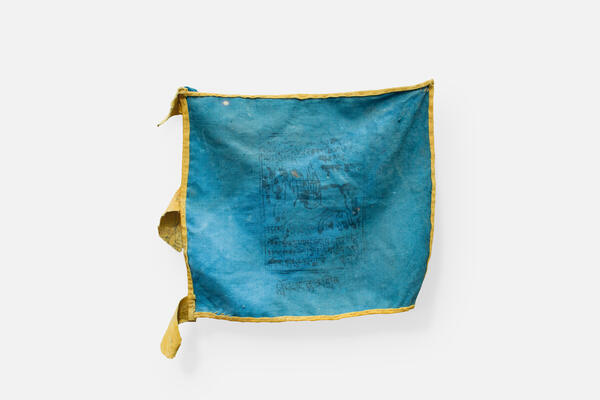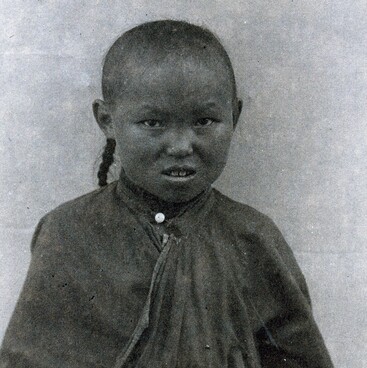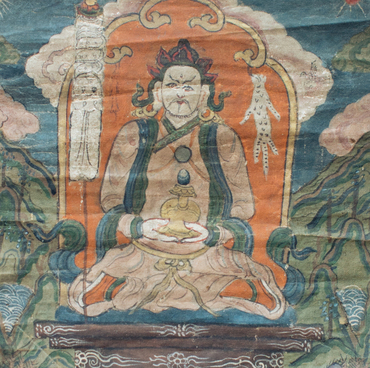In the 18th century, Tibetan Buddhism began to spread over the territory of Tuva from Mongolia. In Tibet, it was preceded by the Bon religion, in which Lungta, horizontal prayer flags, were common.
Lung translates from Tibetan as ‘wind’ or ‘air’. The concept was directly related to prana — human energy. Lungta means ‘wind horse’, the power that protects people. So, Lungta flags received the name for the fact that horses were usually drawn on them.
A person’s vitality was considered one of the most important energies. In Tibet, there is a symbol for it — a horse that carries a jewel on its back (a Chintamani crystal). It is believed to grant wishes and bring prosperity and good fortune.
Lungta flags could be of five basic colors, that referred to the five elements of the macrocosm. Red stood for fire, blue for water, yellow for earth, green for wood, and white for iron. The museum houses a blue Lungta flag with a yellow border along the edges.
Special mantras (prayers) were inscribed on a flag and were supposedly activated upon contact with the wind. They were believed to restore and strengthen a person’s energy.
The figure of a horse was drawn in the center of the flag, and several other characters were depicted in the corners. Each signified a different element and a good quality a person could possess. For example, the Garuda bird symbolized the element of fire and wisdom, the dragon represented water and strength, the snow lion stood for the earth and fearlessness, and the tiger symbolized the air and confidence. Sometimes, instead of making drawings on Lungta, they simply wrote the names of these animals in the Tibetan language.
It was believed that a person who could make a good ‘Wind Horse’ flag would have good fortune in all their affairs and avoid serious health problems. For the ‘Wind Horse’ to carry the prayers to heaven and make them heard, the flags had to be properly positioned, that is suspended at a height where the winds blew frequently. So Lungta flags were usually placed on mountain tops or mountain passes.
Before suspending a flag, a special ritual of Rabné was held to have flags consecrated by lamas. During the ritual, the lama summoned the original wisdom of all the Buddhas to Lungta, and also offered the best day and place to place the flags.
Lung translates from Tibetan as ‘wind’ or ‘air’. The concept was directly related to prana — human energy. Lungta means ‘wind horse’, the power that protects people. So, Lungta flags received the name for the fact that horses were usually drawn on them.
A person’s vitality was considered one of the most important energies. In Tibet, there is a symbol for it — a horse that carries a jewel on its back (a Chintamani crystal). It is believed to grant wishes and bring prosperity and good fortune.
Lungta flags could be of five basic colors, that referred to the five elements of the macrocosm. Red stood for fire, blue for water, yellow for earth, green for wood, and white for iron. The museum houses a blue Lungta flag with a yellow border along the edges.
Special mantras (prayers) were inscribed on a flag and were supposedly activated upon contact with the wind. They were believed to restore and strengthen a person’s energy.
The figure of a horse was drawn in the center of the flag, and several other characters were depicted in the corners. Each signified a different element and a good quality a person could possess. For example, the Garuda bird symbolized the element of fire and wisdom, the dragon represented water and strength, the snow lion stood for the earth and fearlessness, and the tiger symbolized the air and confidence. Sometimes, instead of making drawings on Lungta, they simply wrote the names of these animals in the Tibetan language.
It was believed that a person who could make a good ‘Wind Horse’ flag would have good fortune in all their affairs and avoid serious health problems. For the ‘Wind Horse’ to carry the prayers to heaven and make them heard, the flags had to be properly positioned, that is suspended at a height where the winds blew frequently. So Lungta flags were usually placed on mountain tops or mountain passes.
Before suspending a flag, a special ritual of Rabné was held to have flags consecrated by lamas. During the ritual, the lama summoned the original wisdom of all the Buddhas to Lungta, and also offered the best day and place to place the flags.



